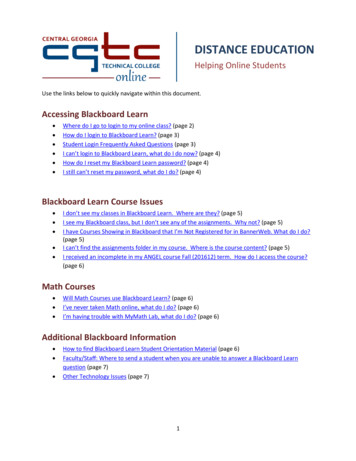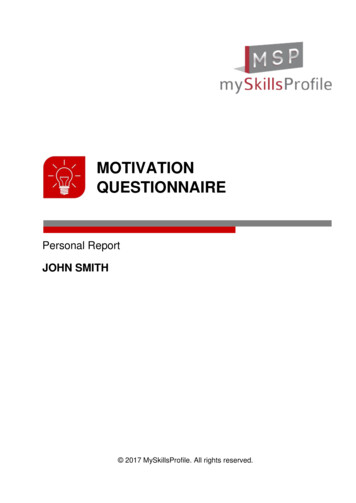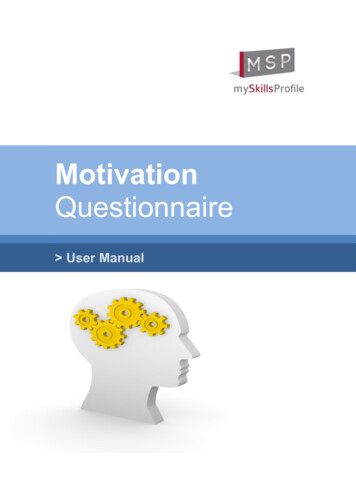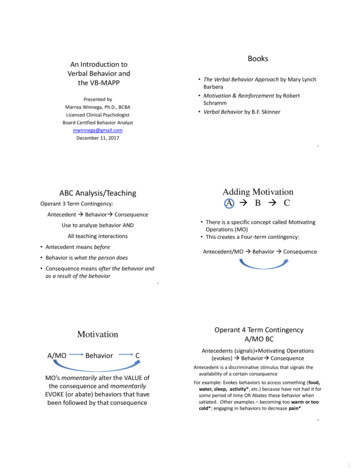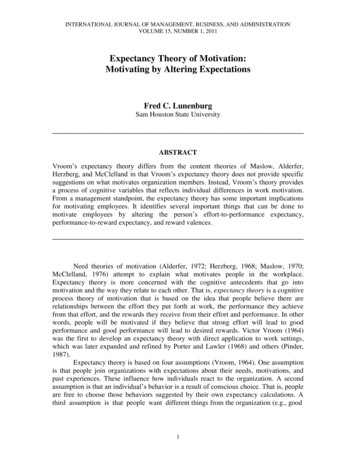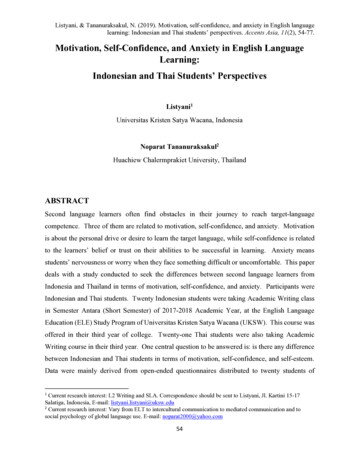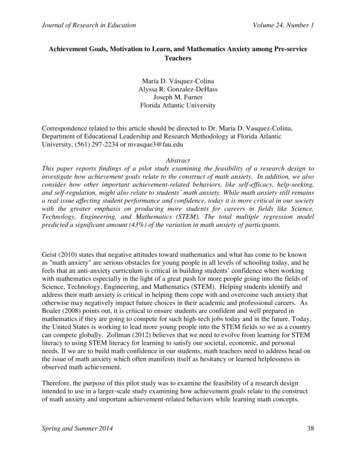
Transcription
Journal of Research in EducationVolume 24, Number 1Achievement Goals, Motivation to Learn, and Mathematics Anxiety among Pre-serviceTeachersMaría D. Vásquez-ColinaAlyssa R. Gonzalez-DeHassJoseph M. FurnerFlorida Atlantic UniversityCorrespondence related to this article should be directed to Dr. Maria D. Vasquez-Colina,Department of Educational Leadership and Research Methodology at Florida AtlanticUniversity, (561) 297-2234 or mvasque3@fau.eduAbstractThis paper reports findings of a pilot study examining the feasibility of a research design toinvestigate how achievement goals relate to the construct of math anxiety. In addition, we alsoconsider how other important achievement-related behaviors, like self-efficacy, help-seeking,and self-regulation, might also relate to students’ math anxiety. While math anxiety still remainsa real issue affecting student performance and confidence, today it is more critical in our societywith the greater emphasis on producing more students for careers in fields like Science,Technology, Engineering, and Mathematics (STEM). The total multiple regression modelpredicted a significant amount (43%) of the variation in math anxiety of participants.Geist (2010) states that negative attitudes toward mathematics and what has come to be knownas "math anxiety" are serious obstacles for young people in all levels of schooling today, and hefeels that an anti-anxiety curriculum is critical in building students’ confidence when workingwith mathematics especially in the light of a great push for more people going into the fields ofScience, Technology, Engineering, and Mathematics (STEM). Helping students identify andaddress their math anxiety is critical in helping them cope with and overcome such anxiety thatotherwise may negatively impact future choices in their academic and professional careers. AsBoaler (2008) points out, it is critical to ensure students are confident and well prepared inmathematics if they are going to compete for such high-tech jobs today and in the future. Today,the United States is working to lead more young people into the STEM fields so we as a countrycan compete globally. Zollman (2012) believes that we need to evolve from learning for STEMliteracy to using STEM literacy for learning to satisfy our societal, economic, and personalneeds. If we are to build math confidence in our students, math teachers need to address head onthe issue of math anxiety which often manifests itself as hesitancy or learned helplessness inobserved math achievement.Therefore, the purpose of this pilot study was to examine the feasibility of a research designintended to use in a larger-scale study examining how achievement goals relate to the constructof math anxiety and important achievement-related behaviors while learning math concepts.Spring and Summer 201438
Journal of Research in EducationVolume 24, Number 1Math AnxietyMath anxiety may be defined as an “ inconceivable dread of mathematics that can interferewith manipulating numbers and solving mathematical problems within a variety of everyday lifeand academic situations” (Buckley & Ribordy, 1982, p. 1). The National Council of Teachers ofMathemtics (NCTM) (1989 & 1995b) recognized math anxiety as a problem and specificallyincluded it in its assessment practices. Standard #10 (NCTM, 1989) prompts teachers to assesstheir students' mathematical dispositions; such as: confidence in using math to solve problems,communicate ideas, and reason.As educators we need to know what causes this dread of mathematics so that it can be preventedand/or reduced. Causes of math anxiety may vary from socioeconomic status and parentalbackground to the influence of teachers and the school system. Ahmed, Minnaert, Kuyper, &vander Werf (2012) examined the reciprocal relationships between self-concept and anxiety inmathematics. A sample of 495 grade seven students (51% girls) completed self-report measuresassessing self-concept and anxiety three times in a school year. The analysis showed a reciprocalrelationship between self-concept and anxiety in math (i.e., higher self-concept leads to loweranxiety, which in turn, leads to higher self-concept). Concluding that math self-concept and mathanxiety are reciprocally related. Some educators believe that teachers and parents who are afraidof math can pass on math anxiety to the next generation, not genetically, but by modelingbehaviors of their own discomfort with the subject. Research by Oberlin (1982) and Furner(1996) found that some teaching techniques actually cause math anxiety; (a) assigning the samework for everyone, (b) covering the book problem by problem, (c) giving written work everyday, (d) insisting on only one correct way to complete a problem, and (e) assigning mathproblems as punishment for misbehavior.Ineffective teaching practices are not the only cause of math anxiety. A student's lack of successwith math may also be a cause of math anxiety and be heightened by any one of several factors:poor math instruction, an insufficient number of math courses in high school, unintelligibletextbooks, or misinformation about what math is and what it is not. Many people often blametheir failures on their lack of a mathematical mind, the notion that men are better than women atmath, or that they have poor memories or learning disabilities. Sheila Tobias, an expert on thetopic of math anxiety since the 1980’s, contends that there are two myths about mathematics thatneed to be eliminated. One is that higher level math is too difficult for otherwise intelligentstudents to master, and another is that without mathematics you can live a productive intellectualand professional life (Tobias, 1993).Willis (2010) gives over 50 strategies educators can use in any grade level to: (1) Rehabilitatenegative attitudes about math; (2) Reduce mistake anxiety; and (3) Relate math to students'interests and goals. Having a better understanding of students' brains can help build foundationalskills in math and other subjects and develop your students' long-term memory of academicconcepts which can then prevent anxiety with mathematics.A study by Perry (2004) indicated that 85% of students in an introductory college level mathclass claimed to have experienced anxiety when presented math problems. Jackson andLeffingwell (1999) showed another perspective in this study, with only seven percent of theSpring and Summer 201439
Journal of Research in EducationVolume 24, Number 1college students in their study not expressing math anxiousness. The prevalence of math anxietyin empirical studies is confounding; however, the effect of math anxiety is well documented.Even in populations of students where math is a foundational skill (e.g. engineering majors incollege), researchers have found math anxiety to be present (Hembree, 1990; Ruffins, 2007).Sparks (2011) feels that as the STEM fields become more important for our students to study,our schools and teachers need to do more to address math anxiety so that our students areconfident to study areas related to STEM. If math anxiety occurs frequently, then attention to themethods that are effective at overcoming math anxiety are important for teacher preparation aswell as for in-service math teachers.There are many things schools can do to help prevent math anxiety. Both teachers and parentsplay a critical role in helping to develop positive dispositions toward math. As with mostintervention programs, early assessment and action help to develop positive math attitudes. Thefield of math education has recently made the push to increase and encourage math literacy, andalong with that push has developed some useful materials to encourage math competence.Reducing math anxiety is much different from preventing math anxiety. While every educatorwould like to prevent a student from experiencing math anxiety, some come to school alreadyworried about being skilled at math. Ooten (2003) in her book, Managing the Mean Math Blues,outlines a four-step method for managing a persons’ math anxiety. Ooten (2003) believes that aperson who suffers from math anxiety needs to first lay the groundwork by coming to terms withtheir feelings and challenge their current beliefs and realize they are not alone; second, one mustchange their thoughts and negative thinking and use intervention strategies to improve one’sthinking that they can be successful at math; third, one needs to know thyself, it is important thatone knows his/her learning style/mode and that he/she applies approaches to doing math bysuccessful people; and lastly fourth, once one has gained some confidence and strategies fordoing mathematics they then must apply what they learned and actually do the math. All ofOoten’s techniques require the teacher to first be aware and second to support the student inturning around their anxiety.Math Anxiety among Preservice TeachersMath anxiety exists in elementary education. Some studies have found that as high as 93% ofpreservice teachers express some anxiety, with anxiety beginning as early as the elementaryschool level (Jackson & Leffingwell,1999; Bekdemir, 2010; Dunkle, 2010; McAnallen, 2010;Blazer, 2011; Westenskow, & Moyer-Packenham, 2012). Many elementary education preserviceteachers never took higher than a formal Algebra class or very many math classes as part of theirstudies to become a teacher (McAnallen, 2010). Some research has found that most elementaryeducation majors reported having poor experiences with math courses in K-12 (Bekdemir, 2010;McAnallen, 2010). Other empirical studies discuss strategies that help in addressing mathanxiety in preservice teachers like best practices such as cooperative groups, manipulatives,journal writing, and discussing feelings, clinical placements, etc. (Dunkle, 2010; Brown,Westenskow, & Moyer-Packenham, 2012).Brown, Westenskow, and Moyer-Packenham, (2011) found that preservice elementary teachers’math anxiety may not necessarily always affect their math teaching anxiety. However, aSpring and Summer 201440
Journal of Research in EducationVolume 24, Number 1teacher’s classroom behaviors, both overt and covert, during math instruction have proven to beinfluential on students’ math anxiety (Jackson & Leffingwell, 1999). In addition, and critical toour line of research, is that a teacher’s motivational goals towards learning can impact students’learning goals, self-efficacy, use of positive coping strategies, and willingness to seek help andask questions (Butler & Shibaz, 2008; Friedel, Cortina, Turner, & Midgely, 2007). A topic weturn to in the coming sections.Overcoming Math AnxietyAs can be seen from the above math anxiety literature, there are many motivational strategiesthat can be used to both reduce and prevent math anxiety which are in line with NCTMrecommendations (1995a). Motivated learning strategies such as removing the importance ofego from classroom practice, emphasizing that everyone makes mistakes in mathematics andeveryone has the capacity to improve, making math relevant, and letting students have someinput into their own evaluations can be very useful in both preventing and reducing math anxietyand improving attitudes toward learning mathematics and then leading students to pursue a widerrange of goals as it relates to future studies and career orientation. Synthesizing across thisliterature, it becomes apparent that many of these motivational strategies overlap with theresearch literature highlighting how influential a student’s goal orientation can be to theirlearning. Therefore, of particular importance to this study was to look at research examining therelationships between preservice teachers’ achievement goals and their levels of math anxiety.The next section introduces the goal constructs and reviews research that has examined how thegoals that students’ adopt relate to their anxiety and fear of failure with particular emphasis onthose studies looking at math anxiety specifically.Goal Orientation TheoryGoal orientation theory examines how the types of achievement goals students adopt are linkedwith important academic outcomes (Ames & Archer, 1988; Conroy & Elliot, 2004; Dweck &Leggett, 1988; Elliot, 2005; Elliot & McGregor, 2001; Ryan, Ryan, Arbuthnot, & Samuels,2007; Sideris, 2008). Elliot and McGregor (2001) proposed a 2x2 conceptualization ofachievement goals: performance approach goal, performance avoidance goal, mastery-approachgoal and mastery-avoidance goal.Students adopting performance goals are motivated to outperform others (performanceapproach) or to avoid failure (performance-avoidance). Students adopting mastery-approachgoals are positively motivated to master a task and advance one’s learning; students adoptingmastery-avoidance goals are negatively motivated to avoid misunderstanding and leaving a taskun-mastered. While mastery-approach goals are related to deep processing, intrinsic motivation,and GPA; mastery-avoidance goals are related to disorganized studying, fear of failure, and testanxiety; performance-approach goals are linked to performance attainment but also sometimes tomore surface-level processing; and performance-avoidance goals are positively linked to testanxiety and negatively linked to intrinsic motivation, exam performance, and GPA (Conroy &Elliot, 2004; Elliot, 2005; Finney, Pieper, & Barron, 2004; Furner & Gonzalez-DeHass; 2011;Ryan et al., 2007; Sideridis, 2008). Of particular interest to this paper is to tease apart how eachof the goal constructs relates to math anxiety specifically.Spring and Summer 201441
Journal of Research in EducationVolume 24, Number 1Few published studies have actually examined the relationship between math anxiety and all fourachievement goal constructs. Bong (2009) reported that elementary and middle- students withperformance-approach, mastery-avoidance and performance-avoidance goals experienced moremath anxiety (with the mastery-avoidance goal showing the strongest relationship with mat
Overcoming Math Anxiety As can be seen from the above math anxiety literature, there are many motivational strategies that can be used to both reduce and prevent math anxiety which are in line with NCTM recommendations (1995a). Motivated learning strategies such as removing the importance of ego from classroom practice, emphasizing that everyone makes mistakes in mathematics and everyone

